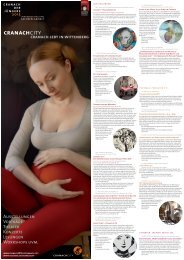In the Footsteps of Cranach - A Journey of Discovery
Twelve German towns and cities have come together in the 'Routes to Cranach' project to bring the life and works of the renowned Renaissance artist Lucas Cranach to the widest audience.
Twelve German towns and cities have come together in the 'Routes to Cranach' project to bring the life and works of the renowned Renaissance artist Lucas Cranach to the widest audience.
You also want an ePaper? Increase the reach of your titles
YUMPU automatically turns print PDFs into web optimized ePapers that Google loves.
7<br />
<strong>Cranach</strong> paints for Meissen Ca<strong>the</strong>dral<br />
Meissen<br />
<strong>In</strong> <strong>Cranach</strong>’s day, <strong>the</strong> town <strong>of</strong> Meissen on <strong>the</strong> river<br />
Elbe had become less influential than Dresden, <strong>the</strong> royal seat<br />
<strong>of</strong> <strong>the</strong> House <strong>of</strong> Wettin, but it none<strong>the</strong>less remained <strong>the</strong> seat<br />
<strong>of</strong> a Protestant ca<strong>the</strong>dral chapter. The Wettins, who had been<br />
invested with <strong>the</strong> Margraviate <strong>of</strong> Meissen in 1089, not only<br />
initiated <strong>the</strong> construction <strong>of</strong> <strong>the</strong> Gothic ca<strong>the</strong>dral but also had<br />
a magnificent mausoleum built in front <strong>of</strong> its west portal from<br />
1415. The memorial stone <strong>of</strong> Frederick <strong>the</strong> Belligerent, Elector <strong>of</strong><br />
Saxony, in <strong>the</strong> royal chapel was cast in <strong>the</strong> workshop <strong>of</strong> Peter<br />
Vischer <strong>the</strong> Elder in Nuremberg. It depicts <strong>the</strong> duke, who<br />
died in 1510, as <strong>the</strong> Grand Master <strong>of</strong> <strong>the</strong> Teutonic Order. It is<br />
thought to be based on a drawing by Lucas <strong>Cranach</strong>, which<br />
would make it <strong>the</strong> oldest reference to <strong>the</strong> artist in Meissen.<br />
View across <strong>the</strong> Elbe to<br />
castle hill in Meissen with<br />
<strong>the</strong> Bishop’s Palace, Ca<strong>the</strong>dral<br />
and Albrechtsburg Castle<br />
The earliest work proven to originate from <strong>the</strong> <strong>Cranach</strong><br />
workshop is <strong>the</strong> ca<strong>the</strong>dral’s retable <strong>of</strong> <strong>the</strong> Crucifixion altar, which<br />
has decorated <strong>the</strong> altar in front <strong>of</strong> <strong>the</strong> choir screen since its<br />
installation in 1526. Duke George, who remained true to <strong>the</strong><br />
Catholic faith, had a small side chapel built at <strong>the</strong> ca<strong>the</strong>dral<br />
for himself and his wife Barbara, who died in 1534, and had it







